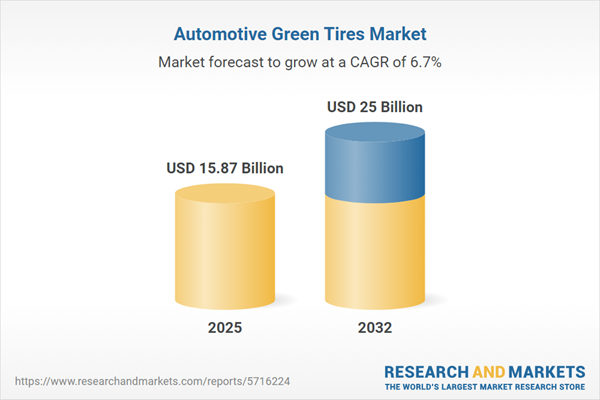Speak directly to the analyst to clarify any post sales queries you may have.
Automotive green tire solutions are reshaping procurement and operational strategies for commercial vehicle leaders, driving forward sustainable practices and compliance across increasingly complex global markets.
Market Snapshot: Automotive Green Tires Market Outlook
The automotive green tires market reached USD 14.85 billion in 2024 and is projected to grow to USD 15.87 billion by 2025, reflecting ongoing momentum through 2032. This consistent growth demonstrates how commercial fleet operators and manufacturers are adopting advanced tire technologies in response to regulatory shifts and sustainability mandates. Stringent global regulations and dynamic standards, combined with rapid tire innovation, shape the market’s expansion across mature and emerging economies. Both transparency in sourcing and efficient recycling operations have become vital, as manufacturers and operators enhance supply chain optimization and lifecycle management to satisfy new compliance, cost, and sustainability objectives.
Scope & Segmentation for Senior Executives
This report is crafted for senior leadership, procurement specialists, and operational strategists seeking comprehensive compliance and improved market positions. The segmentation supports actionable strategies and supplier engagement for automotive green tires:
- Tire Type: Analyzes bias ply and radial tires to match procurement strategies with fleet performance goals and cost-efficiency requirements.
- Technology: Examines developments such as airless tires, composite and polyurethane materials, low rolling resistance, and self-sealing features, providing critical insights for operational adaptability and sustainability gains.
- Material Type: Reviews the use of natural rubber, synthetic rubber, and sustainable compounds, supporting informed decisions for responsible sourcing and supplier collaboration.
- Distribution Channel: Outlines strengths of offline, online, and hybrid models to optimize market access and streamline procurement, reflecting sector-wide integration of digital sales channels.
- Vehicle Type: Provides analysis for heavy and light commercial vehicles and passenger cars, accommodating the different compliance and lifecycle needs of each vehicle segment.
- End Use: Differentiates original equipment and replacement markets, allowing procurement leaders to support both manufacturing and aftermarket integration strategies.
- Regional Coverage: Presents intelligence for the Americas, Europe, Middle East & Africa, and Asia-Pacific, including regulatory trends, adoption rates, and local sourcing considerations.
- Company Coverage: Benchmarks major industry players, such as Michelin, Bridgestone, Goodyear, Continental, Pirelli, Hankook, Yokohama, Kumho, Apollo Tyres, and Sailun Group, with a focus on R&D, product innovation, and market strategies.
Key Takeaways for Senior Leadership
- Bio-based materials and automation in tire manufacturing advance production efficiency, help meet evolving regulatory standards, and facilitate the shift to environmentally conscious product lines.
- Circular supply chain models and increased recycling investments enhance transparency, providing stronger collaboration between fleet operators, manufacturers, and material suppliers.
- Advanced airless and self-sealing technology improves fleet uptime and safety, supporting more resilient logistics operations and reducing maintenance burdens for commercial fleets.
- Strategic cross-supply chain partnerships reduce volatility in material costs, increase access to innovative tire compounds, and bolster flexibility in procurement strategies.
- Expanding use of digital procurement and diversified distribution channels enhances inventory management and allows supply chains to respond efficiently to shifting original equipment and aftermarket needs.
Tariff Impact and Supply Chain Adaptation
Recent updates to U.S. tariff policies have driven procurement teams to restructure supply strategies, prioritize regional manufacturing, and strengthen relationships with local suppliers. These approaches help lower trade exposure and reinforce supply continuity.
Methodology & Data Sources
The analysis leverages executive-level interviews with key tire manufacturers and leading material suppliers. Supplemented by white papers, academic journals, and regulatory documentation, all findings are benchmarked with data triangulation to ensure robust, actionable market insights.
Why This Report Matters
- Empowers leadership teams to embed sustainability into procurement decisions and lifecycle strategies, aligning practices with compliance and market trends.
- Provides thorough benchmarks for supplier selection and innovation, strengthening the resilience and competitiveness of procurement operations.
- Delivers actionable, region-focused intelligence that prepares executive teams for regulatory shifts and new business opportunities in the green tire market.
Conclusion
This report gives decision-makers the insight and tools needed to advance compliance efforts, accelerate sustainability adoption, and optimize procurement strategies as the automotive green tire market continues to evolve.
Additional Product Information:
- Purchase of this report includes 1 year online access with quarterly updates.
- This report can be updated on request. Please contact our Customer Experience team using the Ask a Question widget on our website.
Table of Contents
3. Executive Summary
4. Market Overview
7. Cumulative Impact of Artificial Intelligence 2025
Companies Mentioned
The companies profiled in this Automotive Green Tires market report include:- Compagnie Générale des Établissements Michelin SCA
- Bridgestone Corporation
- The Goodyear Tire & Rubber Company
- Continental AG
- Pirelli & C. S.p.A.
- Hankook Tire & Technology Co., Ltd.
- Yokohama Rubber Co., Ltd.
- Kumho Tire Co., Inc.
- Apollo Tyres Ltd.
- Sailun Group Co., Ltd.
Table Information
| Report Attribute | Details |
|---|---|
| No. of Pages | 197 |
| Published | November 2025 |
| Forecast Period | 2025 - 2032 |
| Estimated Market Value ( USD | $ 15.87 Billion |
| Forecasted Market Value ( USD | $ 25 Billion |
| Compound Annual Growth Rate | 6.7% |
| Regions Covered | Global |
| No. of Companies Mentioned | 11 |









